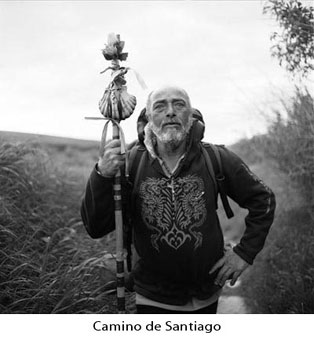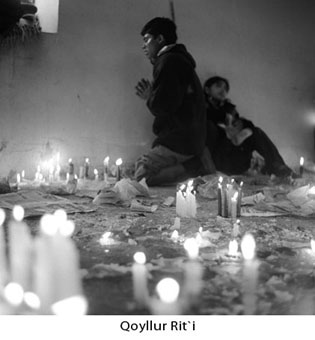WALKING WITH THE STARS
Camino de Santiago (Spain) – Kailash (Tibet) – Qoyllur Rit'i (Peru)
The statistics speak for themselves: In 1999 alone more than 160,000 people made a pilgrimage along the Way of Saint James to Santiago de Compostela. It's a “road” with a long history. Santiago is the city in the Spanish region of Galicia where the tomb of Saint James the Apostle was miraculously discovered in the 9 th century. For Spain of the days of the Reconquista seeking to oppose the Moors it was an amazing stroke of fate. The holy relics became a cult. Soon Santiago was to become the most important place of pilgrimage of the Roman Catholic church alongside Rome and Jerusalem and the earlier road under the stars along which the Celts had travelled and which then became known as The Way of Saint James or Camino de Santiago was one of the most well-known trade routes in Europe. It wasn't until the age of Humanism and Reformation that enthusiasm for this pilgrimage began to die down again. The Way of Saint James was re-discovered in 1984 when Galician bishops asked the Council of Europe to recognize the Camino as a piece of cultural heritage. “Europe was born during a pilgrimage”, according to one Johann Wolfgang von Goethe, “and Christendom is its mother tongue”. The bishops turned out to be right: The Way of Saint James can today call itself the “first European Cultural Route”. Over the past fifteen years it was revitalized, given new signposts and remapped. It is currently experiencing an almost unbelievable renaissance.
There are similar statistics coming out of Peru: More than 20,000 Indios and other interested people from the U.S. and Europe get together each year at Qoyllur Rit'i in the Peruvian Andes to celebrate the feast of the Sacred Ice at the foot of the glacier. The people chip chunks out of the glacier, carry them down to the valley where they let them melt during religious ceremonies and then drink the water. They are rituals with singing and dancing which have their origins in the natural religion of the Indios and have lived on even after the Christianization of South America by the Spanish and Portuguese.
Pilgrimages to Kailash, the Sacred Mountain, in northern Tibet date back many centuries. Pilgrims may not climb to the seat of the gods who the Hindus and Buddhists believe live atop Kailash, but every believer has to have attempted to circumambulate the peak at least once during his or her lifetime. Those who complete the arduous 55 kilometre long pilgrimage, which passes over rough terrain, can thus spare themselves numerous reincarnations, or so they say in Tibet. This walking around the Kailash, it is believed, leads one to the sacred centre of the Earth. For the Americans and Europeans who go on a pilgrimage to Kailash, the trip represents an encounter with a landscape in which one can virtually feel the infinity of time and space.
Three pilgrim ways which unite people of all nations and cultures, which attract curious people from all over the world and join together the faithful of different religions. What is it that drives tens of thousands of hikers to withstand rain, heat and wind, cross the Pyrenees and travel on across the great plateau (meseta) all the way to Santiago? What compels pilgrims from all parts of South America to undertake a week-long journey to climb to the snow glacier and hold out in the freezing cold and thin air until they have carved out chunks of the Sacred Ice? Why do the people in Tibet take it upon themselves to try to overcome a pass at an altitude of 5,000 meters wearing no more than light summer clothing and ordinary shoes only to suffer from shortness of breath, dizziness and sudden feelings of faintness?
Why is it that believers and non-believers alike are fascinated by such pilgrim ways? Is it the spiritual energy of sacred places? Is it the thrill of testing the limits of ones own physical and mental abilities? The lust for adventure? The magic spell of a route where people have pilgrimaged since the Age of Antiquity under the stars? Is it the yearning for the expanse of the Milky Way?
In the search of answers we journeyed along the Camino de Santiago, walked around the Kailash, and have crossed the star glacier Qoyllur Rit'i.
Susanne Schaber ©





































































